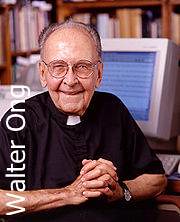Duluth, Minnesota (OpEdNews) September 16, 2025: In the present wide-ranging 4,117-word OEN article, I discuss my life and education briefly, and I succinctly highlight my teaching an introductory-level survey course on the Bible as Literature twenty times over my twenty-two highly productive years of teaching at the University of Minnesota Duluth (September 1987 to May 2009).
During my highly productive years of teaching at UMD, I published my award-winning book Walter Ongs Contributions to Cultural Studies: The Phenomenology of the Word and I-Thou Communication (Hampton Press, 2000). In it, I survey Ongs life and eleven of his books and selected articles. My book received the Marshall McLuhan Award for Outstanding Book in the Field of Media Ecology, conferred by the Media Ecology Association on June 15, 2001.
Now, what I refer to in the subtitle as Ongs Phenomenology of the Word first emerged in his account of the aural-to-visual shift in cognitive processing in our Western cultural history in his massively researched 1958 book Ramus, Method, and the Decay of Dialogue: From the Art of Discourse to the Art of Reason (Harvard University Press; for specific page references to the aural-to-visual shift, see the Index [p. 396]).
Peter Ramus (1515-1572) was the French renaissance logician and educational reformer and Protestant martyr whose work in logic dominated the curriculum of the newly founded (in 1636) Harvard College. For further discussion of Ramus, see Harvards Perry Millers massively researched 1939 book The New England Mind: The Seventeenth Century (Harvard University Press; for specific page references to Ramus, see the Index [p. 528]) Perry Miller served as the director of Ongs massively researched Harvard University doctoral dissertation which Harvard University Press published in two volumes in 1958: (1) Ramus, Method, and the Decay of Dialogue: From the Art of Discourse to the Art of Reason, mentioned above; and (2) Ramus and Talon Inventory, a briefly annotated listing of the 400 or so volumes by Ramus and his allies and his critics that Ong tracked down in more than 100 libraries in the British Isles and Continental Europe (with the financial assistance of two Guggenheim fellowships).
In any event, Ong moved from his 1958 account of the aural-to-visual shift in cognitive processing in our Western cultural history to his account of the human sensorium in his seminal 1967 book The Presence of the Word: Some Prolegomena for Cultural and Religious History (Yale University Press; for specific page references to the human sensorium, see the Index [p. 356]), the expanded version of Ongs 1964 Terry Lectures at Yale University.
In my estimate, not just the chapters of Ongs 1967 book The Presence of the Word, but the entire body of Ongs work from the time of his momentous breakthrough insight in the early 1950s onward constitutes Some Prolegomena for Cultural and Religious History.
Now, Ongs media ecology account of our Western cultural history from the early 1950s onward includes his account of our contemporary secondary oral culture (the culture brought to us by the communications media that accentuate sound such as television, telephone, radio, movies and DVDs with soundtracks, tape-recording devices and the like.
Now, Ong succinctly explains his distinctive sensory approach to The Phenomenology of the Word in his article I See What You Say: Sense Analogues for Intellect in Humann Inquiries: Review of Existential Psychology and Psychiatry, volume 10 (1970): pp. 22-42. Ong reprinted it in his 1977 book Interfaces of the Word: Studies in the Evolution of Consciousness and Culture (Cornell University Press, pp. 122-144). It is also reprinted in volume three of Ongs Faith and Contexts, edited by Thomas J. Farrell and Paul A. Soukup (Scholars Press, 1995, pp. 91-111).
Now, in the present wide-ranging OEN article, I also discuss Ongs work extensively.
In addition, in the Appendix at the end of the present OEN article, I have provided the syllabus of my UMD Bible as Literature course.
Most of the UMD students who enrolled in my Bible as Literature course were familiar only with the so-called literal interpretation of biblical texts. Consequently, I devoted a great deal of time and effort to discussing the idea of interpreting biblical texts but always starting with the literal interpretation.
For an article about interpreting texts, see Ongs article Hermeneutic Forever: Voice, Text, Digitization, and the I in Oral Tradition, volume 10 (March 1995): pp. 3-36. It is reprinted in volume four of Ongs Faith and Contexts, edited by Thomas J. Farrell and Paul A. Soukup (Scholars Press, 1999, pp. 183-204).
Ongs most radical statement about hermeneutic, or interpretation, can be found in his posthumously published book Language as Hermeneutic: A Primer on the Word and Digitization, edited by Thomas D. Zlatic and Sara van den Berg (Cornell University Press, 2017).
Now, when I was in the Jesuits (1979-1987), I did my theological studies at the Jesuit theologate at the University of Toronto. Of course, my theological studies included taking certain graduate courses in biblical studies, including one memorable course on the Fourth Gospel taught by the Canadian Jesuit biblical scholar David M. Stanley (1914-1996), the author of the book titled I Encountered God!: The Spiritual Exercises [of St. Ignatius Loyola] with the Gospel of Saint John (Institute of Jesuit Sources, 1986). Yes, as the words in quotation marks in the title suggest, Father Stanley argues that the author of the Gospel of Saint John had encountered God in his own personal spiritual life and was as a result moved to write the Gospel of Saint John as a kind of spiritual biography, in effect.
Next Page 1 | 2 | 3 | 4 | 5 | 6 | 7 | 8 | 9 | 10 | 11 | 12 | 13 | 14 | 15 | 16 | 17 | 18
(Note: You can view every article as one long page if you sign up as an Advocate Member, or higher).





